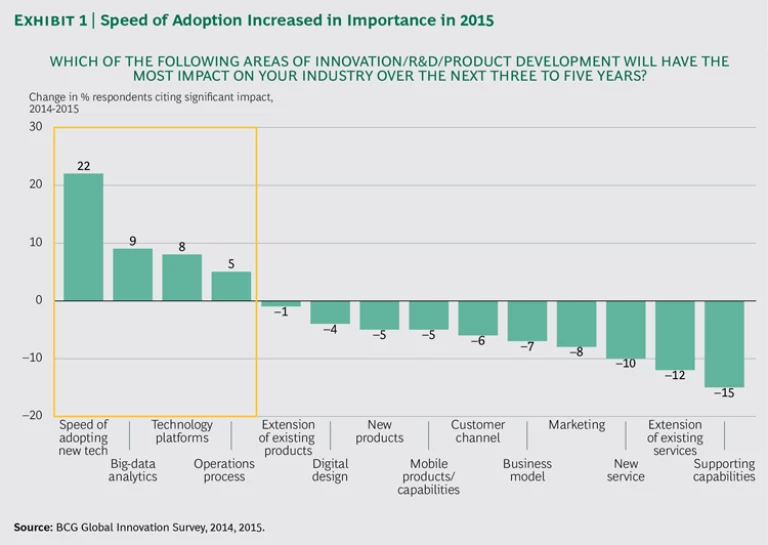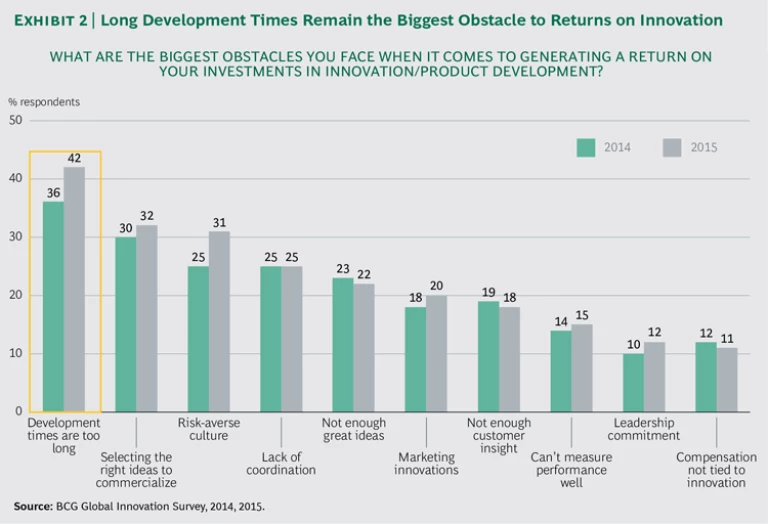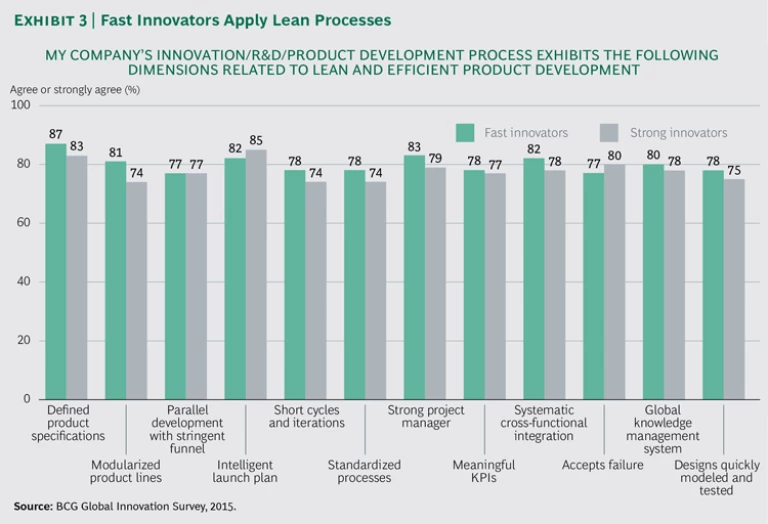This article is an excerpt from The Most Innovative Companies 2015: Four Factors that Differentiate Leaders (BCG report, December 2015).
Size can give you scale, but for innovation, speed is more critical,” says Rakesh Kapoor, CEO of Reckitt Benckiser, the breakthrough-innovator consumer products company that we profiled in BCG's 2014 report on the state of innovation at companies worldwide. Speed has long been seen as an important attribute of strong innovators. The results of the survey underpinning this year's report, as well as our recent work with clients, indicate that its importance is rising fast. (See Exhibit 1.) Speed enables companies to catch consumer trends as they emerge, leave competitors flat-footed, and even drive costs down and quality up.
In our 2015 survey, overly long development times were the most-cited obstacle to generating returns on innovation and product development; 42% of global innovation executives said development times are too long—a 6 percentage point increase over 2014. (See Exhibit 2.) The same frustration is shared by strong, average, and weak innovators in roughly equal measure, but there the similarities end.
Fast innovators are much more likely to also be strong innovators—42% compared with less than 10% of slow innovators. Fast innovators are more disruptive—27% versus 1.5%. They get new products to market quickly and generate more sales from them (at least 30% of revenue). This is true for 35% of fast innovators but for only 11% of slower ones.
One example is fashion retailer Zara, part of the Inditex Group, the world’s largest apparel seller. Zara lives by speed. The typical fashion retailer is organized around individual functions to gain scale and cost advantages; as a result, product development, manufacturing, and delivery take months. Zara gets new styles to market in two to four weeks. To do so, it uses a cross-functional, integrated organization to accelerate decision-making and eliminate delays in functional handoffs. Design, procurement, manufacturing, and delivery are all organized into teams that work closely with store managers to quicken responsiveness to shifting market trends. Team performance is assessed on the basis of common metrics and incentives that focus on go-to-market speed and rapid lead times. As the former CEO of Inditex, José Maria Castellano, puts it, “This business is all about reducing response time. In fashion, stock is like food. It goes bad quick.”
The Benefits of Speed
Increasing speed to market leads to numerous financial and nonfinancial benefits. Greater agility has the potential to boost a company’s top and bottom lines, and flexible and mobile consumers demand it. The financial benefits are often directly measurable and vastly exceed the up-front costs of introducing speed-to-market approaches to the organization. Some examples of the benefits of speed:
- Faster Innovation. Companies that are built for speed often realize first-mover advantages; they are able to react more quickly to competitors’ moves or market shifts with their own product innovations.
- Lower Development Costs. Streamlined processes, limited iterations, and reduced slack release financial and operating resources for other value-adding activities.
- Larger Market Share. A product that gets to market early is less likely to face initial competition. A quick introduction also gives a product more time to build market share before it declines into a commodity.
- Greater Forecasting Accuracy. Because the time between product design and product release is shorter, executives may be more willing to green-light trendy products that would otherwise be denied.
Designing the System for Speed
From an innovation perspective, there are two aspects to speed: the rate at which companies develop new products and services, and the rate at which they deliver those products and services to market. Some companies emphasize one or the other; for example, innovation leaders stress development and fast followers focus on delivery. That said, companies that have designed their systems, organizations, processes, and cultures for speed in either context tend to have four things in common: they apply lean processes, prototype and iterate, have dedicated innovation staff, and follow the right metrics.
- Apply lean processes. The lean philosophy emphasizes speed as much as it does quality, efficiency, and elimination of waste. This year, for the first time, we asked our survey respondents to rate their companies’ innovation and product development activities on 12 dimensions related to lean and efficient product development, including short cycles and iterations, standardized processes, and the quick modeling and testing of designs. (See Exhibit 3.) When we segmented the responses by self-described strong and fast innovators, we found a close correlation between these two groups—and a high degree of employment by both of lean principles across all 12 dimensions. (Separate BCG research corroborates these results: the companies that deploy the principles of lean R&D reduce timelines by double-digit percentages, as well as increasing efficiency and overall value. For more on how they have achieved these results, see one of the companion articles in this series, “ Strong Innovators Are Lean Innovators .”)
- Prototype—to get customer input fast. Many companies wait until a new product is perfected before designing an elaborate launch. Fast innovators test prototypes with customers, worrying less about the imperfections that they know are there and focusing more on the insights they may gain from consumer reactions and feedback. These are incorporated quickly in the next design iteration, and another prototype is developed and tested. Using an adaptive approach, good innovation systems take advantage of the experience curve to speed up the entire process. They also fail fast and fail cheap—cutting losses sooner than a standard innovation playbook might suggest and limiting the waste created by going too far down unproductive paths. It’s an approach that may sound intuitive and simple, but it’s a difficult one for many large organizations to implement, since it runs counter to most entrenched corporate cultures.
- Dedicate people and resources to the task. Experts debate the benefits of centralized versus decentralized innovation organizations (respondents to our survey were split as well), but what’s most important is to have dedicated capacity. If innovation is 10% of 100 people’s responsibility, you can guarantee that little innovation will take place. But if it’s 100% of 10 people’s job, things will start to happen. Speed is partly born of the priority that is put on it, so assigning—and incentivizing—a dedicated team with the job of moving fast is an essential organizational move. Strong innovators put committed muscle behind reducing the time to market: they create fast-track programs, their own special processes, dedicated production capacity, established toolboxes (designed for speed), and teams. Typically they are able to reduce time to market by a factor of four.
- Set and follow the right metrics. We are what we measure, but companies too often measure the wrong thing. Metrics that put the emphasis on incremental progress, or progress against a single component of a larger whole, can cause individuals and teams to focus on their particular tree while losing sight of the forest. The best-performing innovators measure and incentivize teams on their overall achievement of company goals.
Fast innovators have long demonstrated that shortening innovation and product development cycles and reducing time to market can be a powerful source of competitive advantage. But a growing emphasis on speed, even among companies that are already fast, suggests that a new realization is dawning: the demand for speed is itself increasing.









